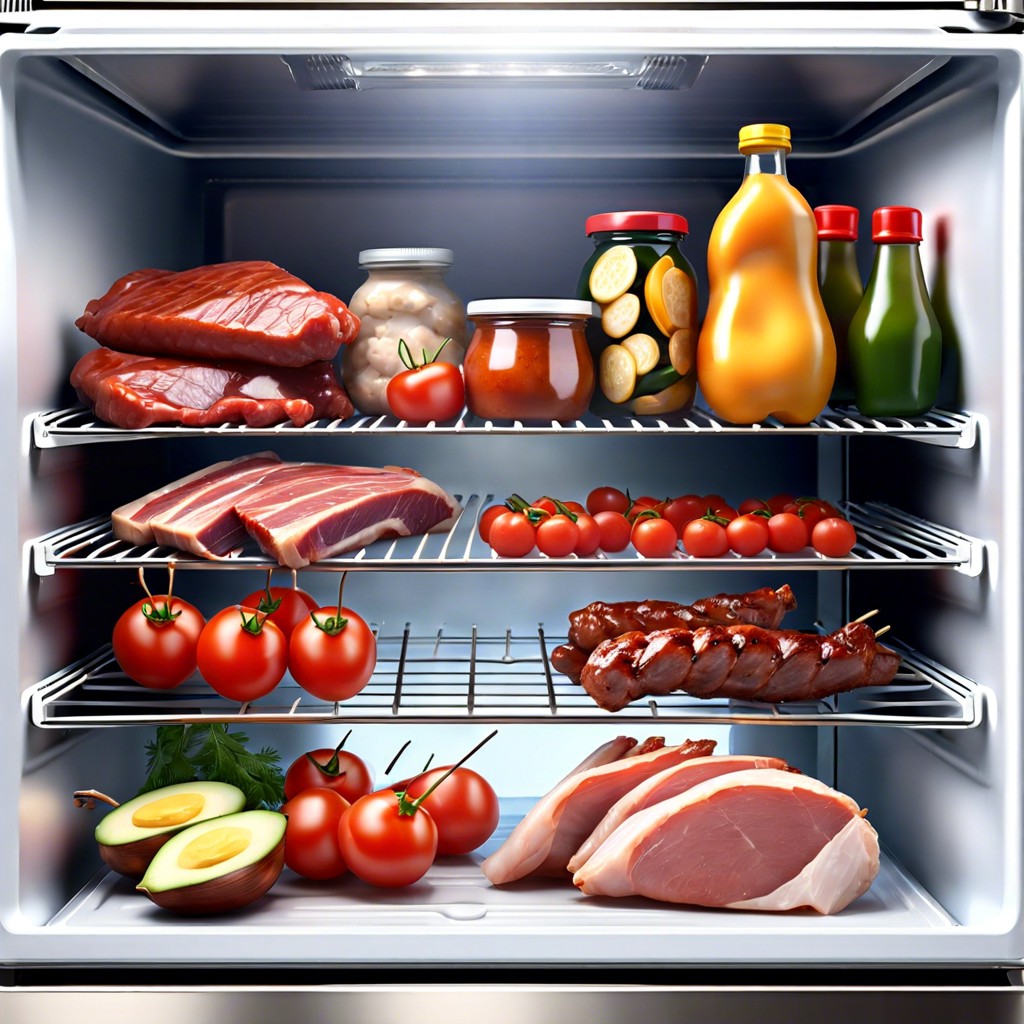Discover the optimal duration for safely storing barbecue in the refrigerator to maintain its flavor and prevent foodborne illness.
Key takeaways:
- Cool meat quickly to prevent bacterial growth.
- Use shallow, airtight containers for storage.
- Refrigerate within 2 hours (or 1 hour in high temperatures).
- Keep fridge at 40°F or below to inhibit bacteria.
- Different meats have varying refrigeration periods, labeled containers.
Safe Storage of Barbecue

To ensure your barbecue remains safe for consumption, follow these storage practices:
- Cool the meat quickly to thwart bacterial growth by dividing it into smaller portions if necessary.
- Use shallow, airtight containers to maintain moisture levels and prevent contamination.
- Refrigerate promptly, ideally within two hours of cooking, or one hour if the ambient temperature exceeds 90°F (32°C).
- Keep your fridge at 40°F (4°C) or below, the safe zone for inhibiting bacterial proliferation.
Adhering to these strategies minimizes the risk of foodborne illness and helps preserve the quality of your barbecue.
Guidelines On Refrigeration Periods for Different Types of Barbecued Meat
Pulled pork, brisket, and ribs generally retain quality for up to four days when refrigerated at 40°F (4°C) or below. Chicken, with its higher likelihood of bacterial growth, is best consumed within three days.
Rare beef holds well for a shorter period, up to three days, due to its lower internal cooking temperature which may not eliminate all bacteria. It’s crucial to cool barbecue swiftly before refrigeration; divide large portions into smaller, shallow containers to expedite cooling and prevent the proliferation of bacteria.
Always use airtight packaging or wrap tightly in heavy-duty aluminum foil or plastic wrap to minimize exposure to air, which can degrade flavors and promote spoilage. Remember, these time frames are guidelines to maximize safety and quality — fresher is always better.
How to Properly Package Barbecue for Refrigeration
To ensure that your barbecue remains at its best while stored in the fridge, follow these packaging tips:
- Allow meats to cool slightly, but do not leave at room temperature for more than two hours to prevent bacterial growth.
- Wrap the meat tightly in aluminum foil or plastic wrap, pressing out as much air as possible to minimize oxidation and moisture loss.
- For extra protection, place the wrapped meats in airtight containers or heavy-duty freezer bags.
- Label the containers with the date of refrigeration to keep track of how long they’ve been stored.
- Separate different types of meats into individual containers to prevent cross-contamination and to preserve unique flavors.
- If sauces were used, store them in separate containers, as their shelf life may differ from the meats.
Effective packaging is not only about maintaining food safety but also about preserving the quality and taste of your barbecue for future enjoyment.
Signs of Spoilage in Barbecued Foods
Detecting spoilage in barbecued foods is crucial to ensure safety and prevent foodborne illnesses. Be on the lookout for:
- Odor Changes: Freshness is often accompanied by smoky, savory aromas. If your leftover BBQ emits a sour or unpleasant smell, it’s a clear signal that bacteria have taken hold.
- Texture Alterations: Barbecued meats should retain a certain degree of moisture and firmness. A slimy or tacky texture can indicate spoilage.
- Color Shift: While some color changes may occur naturally as meat cools and oxidizes, be wary of dramatic shifts or hues that seem unnatural, such as grays or greens.
- Mold Growth: Any visible mold, no matter how small, means that the food is no longer safe to consume and must be discarded immediately.
- Taste: If there’s an off-taste that doesn’t align with the rich, hearty flavors typically associated with BBQ, trust your palate and dispose of the meat.
Always inspect barbecue leftovers with these points in mind before deciding to indulge again. Your health takes precedence.
How to Reheat Barbecue
Reheating barbecue is a delicate process; maintaining moisture and flavor is paramount. The best method depends on the type of barbecued meat. For brisket and pulled pork, a low-temperature oven (around 250°F) is ideal. Wrap the meat in foil with a splash of apple juice or beef broth and heat until the internal temperature reaches 165°F. This method allows the meat to reheat slowly, preserving its juiciness.
For ribs, brush them with a thin layer of sauce to add moisture, wrap in foil, and reheat in the oven at the same temperature until warmed through. Chicken, due to its leaner nature, requires extra care to avoid drying out—consider covering it with foil and adding a bit of chicken stock or butter.
If time is of the essence, using a microwave is feasible; however, it should be on a low power setting and in short intervals to prevent the meat from becoming tough. Cover the meat with a damp paper towel to keep moisture in.
Grilling is an alternative to impart a fresh smoky flavor. Lay the meat on a cooler section of the grill, using indirect heat, and cover it with foil. Keep a close eye on the temperature and the barbecue’s texture to ensure it doesn’t dry out or burn.
Related
- How Long Does BBQ Last in the Fridge: Safe Storage Tips and Guidelines
- How Long is BBQ Sauce Good for in the Fridge: Tips to Maximize Shelf Life
- Does BBQ Sauce Go Bad? Understanding Shelf Life and Storage Tips
- How to Reheat Ribs: Best Methods for Juicy, Flavorful Results
- How to Grill Frozen Hot Dogs: Easy Steps for Tasty Results